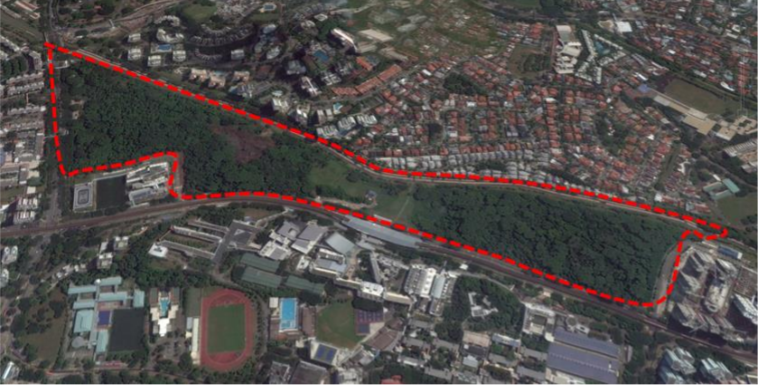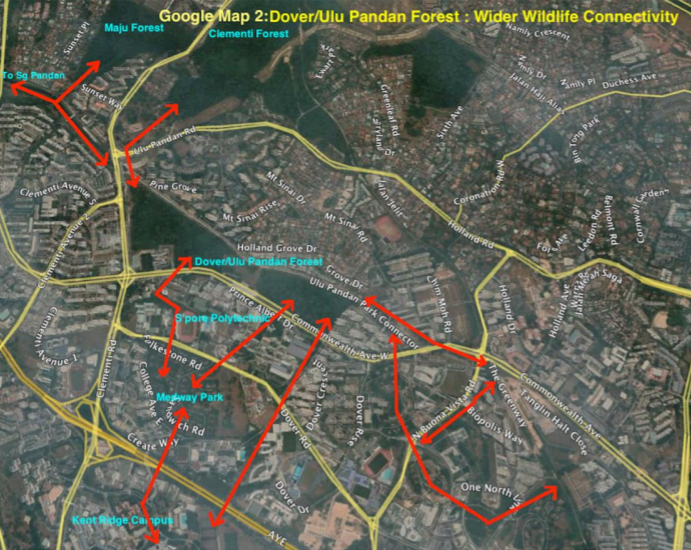Fill Me In
Residents in the Dover/Ulu Pandan estate might soon be losing a prime plot of greenery — it has been announced that Dover Forest is slated for residential development. Since the announcement has been made, the public and nature groups alike have voiced their concerns and hopes that the space can be conserved instead. Members of Parliament have also spoken out on the issue.
About Dover Forest
An environmental baseline study of the 33 hectares Dover/Ulu Pandan estate released by the Housing Development Board (HDB) highlights that the Dover forest was part of a rubber plantation from the 1920s to the 1940s. It was subsequently abandoned after World War II. Since the 1980s, the land has been relatively untouched.
Today, approximately half of the land area of the forest comprises secondary forest that regrew from plantations or kampungs.
Dover Forest is also a safe haven for biodiversity. HDB’s environmental baseline study has recorded 120 species of plants and 158 species of animals within the Dover Forest. More importantly, 16 locally threatened species of plants and 27 large trees of significance were identified. Furthermore, six locally critically endangered or endangered species of animals have also been observed in the Dover Forest.
Besides being a home to a wide range of biodiversity, the Dover Forest also plays an integral role in other natural processes. This includes remediating rainwater which eventually flows into Pandan Reservoir, acting as a carbon sink, mitigating soil and slope erosion, and more.
The redevelopment of Dover Forest
HDB has announced that it will offer new flats in the Ulu Pandan estate this year. Subsequently, the environmental baseline study was published to assess the potential impact any developments will have on the environment. This includes assessing the biodiversity within the area as well as the distribution of flora and fauna within Dover Forest.
The study was conducted for the area highlighted below:

Members of the public were allowed to present their feedback on this issue to the government for consideration up till 16 January 2021.
Public response to the announcement
Dover residents have since expressed their disappointment in losing this little oasis. A petition to protect the forest started by a resident of the estate, Sydney Cheong, has since drawn over 32 thousand signatures at the time of writing.
Other members of the public have spoken out about the issue, citing their personal positive experiences of spotting wildlife in the area or enjoying the cooling-off benefits that the green space provides.
Nature Society (Singapore)’s response
Nature groups such as Nature Society (Singapore) (NSS) have also chimed in on the issue.
The NSS has come up with a 13-page counter-proposal based on their own research and ended off with proposed suggestions of land use.
Ecological significance
In their report, they highlighted that there are actually 21 more bird species within Dover Forest than stated in the environmental baseline study, with an additional five of them being classified as endangered. Two of the bird species are globally endangered.
Moreover, the NSS highlighted the ecological value of Dover Forest in serving as a “stepping stone” for wildlife due to its prime location which allows for wildlife connectivity in the region. Dover Forest’s location allows wildlife to access a number of other green spaces such as Pandan Reservoir, Bukit Timah Nature Reserve, Clementi Forest, and forests of the Southern Ridges. This has been illustrated in the image below:

Benefits to residents
The NSS also addressed in their report the potential benefits that conserving the space can bring to residents in the area. They emphasised the lack of public parks in the Dover/Ulu Pandan estate, and the high demand of green areas from the general public who have been flocking to Clementi Forest and other nature parks over the weekends.
As such, they have proposed that instead of converting Dover Forest into a residential area, it should instead be turned into a public-cum-nature park to allow for conservation while still enabling accessibility to the public.
Public-cum-nature park counter-proposal
NSS’ proposes to demarcate three areas within the park: (1) wildlife core and corridor area; (2) public park area; and (3) community garden and recreational facilities area. This has been illustrated in the following image:

These wildlife core and corridor area will be conserved as an untouched plot to ensure the utmost protection of the environment and existing biodiversity. To allow the public to still enjoy an immersive forest experience, the NSS suggests that a trail be created at the northern boundary of the forest corridor while leaving the core area alone.
The second area (public park area) will be situated near the park connector and can be developed for general recreational and exercise use. Finally, the community garden and recreational facilities area will see the most development, with suggestions such as food courts for the public. However, the NSS reiterates the need for some greenery to be integrated within this space to still allow for wildlife connectivity.
Alternative plots for residential development
Instead of carrying out residential development in the Dover Forest area, the NSS proposes three alternative locations:
- Open patch at the junction of Ghim Moh Road and Commonwealth Avenue West
- Degazetted Warren Golf Course to the east of Medway Park
- Open patch at the junction of Dover Road and North Buona Vista Road, opposite INSEAD
Politicians’ speak out
Two leaders of the Workers’ Party (WP), Dennis Tan and Nicole Seah, have made statements on social media to share their thoughts on the issue. They have both expressed their hopes that the government will release the outcomes of public feedback and consultation sessions to the public.
Meanwhile, Member of Parliament (MP) for Holland-Bukit Timah GRC’s Ulu Pandan Division, Christopher de Souza, has filed an adjournment motion in Parliament which will allow him to raise the issue for discussion in parliament. He intends to explore other vacant sites which could be used for development instead.
MP Louis Ng, who is the Chair of the Government Parliamentary Committee on Sustainability and the Environment, has also said that he will raise this topic in Parliament.
Join the conversations on THG’s Facebook and Instagram, and get the latest updates via Telegram.












